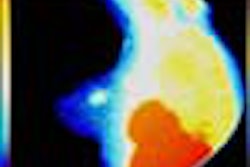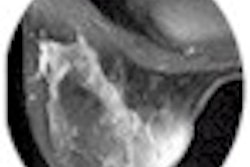Since the FDA approved the first full-field digital mammography (FFDM) system in January 2000, debate has centered on whether the expensive new technology really performs better, or even as well as, standard screen-film mammography (SFM). To date, only a few studies have compared the modalities head to head, and the reported differences have been mostly underwhelming.
Part of what makes comparison difficult is that the technologies have different strengths. For example, FFDM has lower spatial resolution than SFM -- about 5 line pairs per millimeter vs. 12 or more line pairs for SFM. Yet digital images have better contrast resolution than SFM, and contrast is often what counts for detecting abnormal structures in breast tissue.
In one of the largest comparisons so far, a study in this month's Radiology compared FFDM with standard screen-film mammography in 4,945 paired examinations. Of 36 breast cancers discovered at biopsy, FFDM found 21 and SFM found 23. The authors concluded that while there is no statistically significant difference in cancer detection between the modalities, FFDM has led to fewer recalls, and thus a higher positive biopsy rate than SFM (Radiology, March 2001, Vol.218:3, pp. 873-880).
On the other hand, several studies presented earlier this month at the 2001 European Congress of Radiology conference found FFDM's performance to be superior to SFM's at lower radiation doses -- at least for detecting ersatz abnormalities in acrylic phantoms.
Detecting abnormal structures
At the ECR's digital mammography sessions, medical physicist Klaus Hermann from the University of Göttingen, Germany, presented a study comparing the radiation dose of FFDM to that of SFM. The researchers found that digital mammography offers significant potential for lowering radiation dose, or alternatively, finding more breast abnormalities with the same radiation dose as screen-film mammography.
The researchers obtained images of a polymethylmethacrylate (PMMA) phantom using both an FFDM system (Senographe 2000D, GE Medical Systems, Waukesha, WI) paired with another GE system that was identical except for its dedicated mammographic screen-film combination (Fujifilm Medical Systems USA, Stamford, CT).
The digital receptor is a cesium iodide-covered flat-panel amorphous silicon detector with a pixel size of 100 microns. Both systems used a dual-track x-ray tube with a molybdenum/rhodium track on the anode and molybdenum or rhodium filtration.
The phantom contained 16 cells that simulated different anatomic structures found in breast tissue, Hermann said.
"Six cells represented 5 structures with cross sections from 1.56 mm to 0.40 mm," he said. "Five cells represented microcalcifications with diameters from 0.54 mm to 0.40 mm. Five cells represented microcalcifications from 0.54 mm to 0.16 mm. Five cells represented tumors and masses with thicknesses 2 mm to 0.25 mm."
The images were evaluated on a high-resolution workstation by two radiologists who counted the number of correctly detected objects, then plotted the number of correctly detected objects for the three targeted filter combinations: molybdenum/molybdenum (Mo/Mo), molybdenum/rhodium (Mo/Rho), and Rho/Rho. Two phantom images were acquired under each imaging condition, and each image was scored independently.
According to Hermann, the dose values of FFDM were not significantly different from those of conventional SFM. Raising peak voltage by 2 kVp decreased the average glandular dose by 8-13% for the same target/filter combination, he said. Changing the target/filter material from Mo/Mo to Rho/Rho lowered the breast dose by about 40% at the same peak voltage values.
"Given that peak voltage has a significant effect on lesion detection, use of the lowest peak voltage possible seems preferable. But peak voltage also has a significant effect on x-ray output, with higher kVp decreasing exposure time for a fixed detector dose. This indicates that the preference for using the lowest possible peak voltage (is limited) by the requirement that exposure times be kept relatively short," Hermann said.
Changing the target/filter combination from Mo/Mo to Mo/Rho decreased mean glandular dose by about 10%, while changing to Rho/Rho decreased the mean glandular dose by approximately 30% for the same peak voltage. The best point was Rho/Rho target/filter, 3 missed details, 27 kVp, Hermann said.
"FFDM provides an increased number of correctly detected lesions compared to screen-film mammography," he said. "The lower detection level of screen-film mammography is achieved by the digital system at a 30% lower dose."
The results are valid only for the 5-mm-thick standard breast simulated by the phantom, Hermann said, noting that the next phase of the study will investigate the effects of varying composition and thickness.
Microcalcifications
In another study, Dr. Silvia Obenauer, also from University of Göttingen, used the two systems to compare contrast detail curves and the detection of microcalcifications in an anthropomorphic breast phantom.
The study used the same GE Senographe 2000D and GE screen-film mammography systems to obtain images of a contrast-detail mammography phantom and an anthropomorphic breast phantom with superimposed microcalcifications.
The digital images were obtained with the same radiation dose used for the SFM system, and at reduced doses of 75%, 50%, and 25% of the standard dose. Three radiologists independently evaluated contrast detail, calculating the correct observation ratio for each dose, and performing receiver operator characteristics (ROC) analysis using confidence levels of 1 to 5 for each image.
At the same dose level, digital mammography provided an equivalent or higher detectability rate than conventional mammography, Obenauer said.
"The dose can be reduced up to 50% to reach the same detectability as 100% of the screen-film system’s (dose). Detectability of microcalcifications, for example, was increased in magnification view (by) 80% in the digital, compared to 60% in the conventional system," Obenauer said. Moreover, similar ROC curves could be produced with up to a 50% dose reduction in the digital system.
"The results suggest that FFDM is at least equivalent, or as far as contrast is concerned, superior to conventional SFM concerning the detectability of simulated lesions," Obenauer said. "Thus, the potential of dose reduction in digital techniques is suggested."
Low-contrast objects
Hermann then presented a third study comparing the same digital and conventional mammography systems -- this time in the detection of low-contrast objects.
For this study, the researchers used a contrast-detail phantom that contained gold disks ranging in size from 0.1-3.2 mm and from 0.05-1.6 µm. The SFM images were obtained using the automatic exposure system, and on the digital system using dose reductions of 25%, 50%, and 75% of the SFM dose. Three radiologists compared each image, and contrast-detail curves were created and compared with the resulting data.
Although the digital system had lower spatial resolution than the conventional screen-film system (5 and 12 line pairs per millimeter, respectively), contrast detail proved to be a better indicator of their relative sensitivity, Hermann said.
"As you saw in the presentation of Dr. Obenauer, the digital system with lower spatial resolution has the same or better detection rate than the conventional screen-film system," Hermann said, noting that the difference was even more pronounced in his study of low-contrast objects.
His results showed that independent of phantom thickness, "the contrast detail resolution of the conventional mammographic system was reached by the digital system at 70% of (its radiation dose); dose speed class 12."
Not only did FFDM show significantly better contrast detail at 70%, it had superior lesion detection capabilities, down to about 50% of the dose used in the screen-film system, Hermann said.
Session moderator Dr. Román Rostagno asked Hermann about the study's implications.
"Would your conclusion be that you lower the dose of the digital system to 70% of the system dose of the screen film, or would you use the same dose and take advantage of the better results?" he said.
"That's a good question," Hermann replied. "We don't need the best image quality, we need adequate image quality. And nobody can tell me what adequate image quality (is). Must we see all microcalcifications, for example, or is it enough that we see all microcalcifications greater than 150 micrometers? Don't forget that the doses are very small compared with the doses 10 years ago. I think the doses we use today are small enough."
By Eric BarnesAuntMinnie.com staff writer
March 28, 2001
Related Reading
Film-screen mammography remains gold standard, IOM says, March 8, 2001
Full-field digital mammography holds its own against screen-film mammography, March 4, 2001
Full-field digital mammography compares well to screen-film, November 27, 2000
Full-field digital mammography is finally ready for prime time, November 26, 2000
Click here to post your comments about this story. Please include the headline of the article in your message.
Copyright © 2001 AuntMinnie.com



















